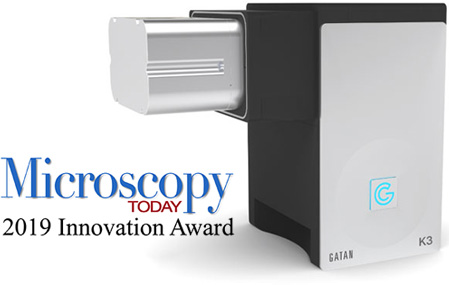Low Dose Electron Microscopy (TEM) for Beam-Sensitive Materials
How to use low dose electron microscopy (TEM) to observe beam-sensitive materials, with new electron counting camera technology. This gives you high resolution images and longer observations, with greatly reduced damage to your sample. This opens up TEM studies on catalyst dynamics and sensitive materials such as metal-organic frameworks.
Gatan’s K3 IS camera has won a Microscopy Today Innovation Award 2019, as the world’s first counting, high-speed, large format camera for in-situ microscopy.
Blue Scientific is the official distributor for Gatan cameras and systems for electron microscopes in the Nordic region (Norway, Sweden, Denmark, Finland and Iceland). For more information or quotes, please get in touch.
Gatan K3 IS camera
Contact us on +44 (0)1223 422 269 or info@blue-scientific.com
Follow @blue_scientificElectron Beam Effects in TEM
In TEM (Transmission Electron Microscopy), the electron beam can be harmful to certain types of samples, in ways that are not always fully understood or accounted for. This makes it difficult to image some kinds of materials.
To reduce these electron beam effects, usually the electron dose is limited. Unfortunately this also limits spatial/temporal resolution and/or the length of your study.
Reduced Damage with Electron Counting
Recently there have been breakthroughs in cryo-EM, due to new camera technology. Cryo-EM is a low electron dose TEM technique, often used for sensitive biological samples.
At low electron doses, almost every electron that passes through a sample can now be identified and counted individually. The quality of the resulting images is unprecedented.
This electron counting technology reduces the detrimental effect of the electron beam, making studies feasible that would previously have been challenging, for example:
- Catalyst dynamics
- Sensitive materials eg metal-organic frameworks (MOFs)
- Longer continuous observations, with higher resolution
How Electron Counting Works
This quick video explains the principle of electron counting in less than 2 minutes:
Example: Metal-Organic Frameworks
In the example below, you can see the accumulation of electron counts in a single image of a MOF sample over 3 seconds. Previously it would not have been possible to image metal-organic frameworks at such high resolution, because they would have been destroyed by the electron beam.
This was taken using the Gatan K2 Summit camera. The individual frames were aligned before summing to generate the final image.
- 120 individual frames over 3 seconds
- Dose rate: 1.4 e–/Å2/s
- Total dose: 4.1 e–/Å2
Courtesy of Zhu, Y., Ciston, J., Zheng, B., Miao, X., Czarnik, C., Pan, Y., Sougrat, R., Lai, Z., Hsiung, C.-E., Yao, K., Pinnau, I., Pan, M., Han, Y., 2017. Nat. Mater. 16, 532–536.
Example: Beam-Sensitive Zeolite
The video below is of a beam-sensitive zeolite sample (Si/Al ratio 1.2). To show the difference that counting makes, the video compares results from two different cameras, one with counting and one without:
- LEFT: Non-electron counting – Taken with a Gatan Rio 16 IS camera which is highly sensitive, but does not count electrons.
- RIGHT: Electron counting – Taken with a Gatan K3 IS camera in electron counting mode. The same microscope was used, on a new location on the sample.
As you can see, counting gives you better detail at a high spatial resolution, even at a low dose rate.
Both datasets were acquired with the same parameters:
- 20 frames per second
- Low dose rate: 10 e-/Å2/s
- Total dose: 175 e-/Å2.
Sample provided to Gatan by Shery Chang of Arizona State University.
Example: Heating Alloys In-Situ
This final example is a counted in-situ TEM video. A Cu-Sn alloy (10:90) was heated to 600⁰C using an in-situ heating system. At this temperature the alloy dissociates, leaving pure Sn particles of various sizes.
- 20 frames per second (2 minute video)
- Low dose rate: 27 e-/Å2/s
- Total electron dose: 3240 e-/Å2
A traditional TEM camera would require at least 5 times this dose rate to achieve a similar result.

Gatan K3 IS
World’s first electron counting, high-speed, large format camera for in-situ microscopy
- Up to 1200 fps
- Large field of view: 14 or 24 megapixels (up to 5,760 x 4,092)
- Low dose for beam-sensitive materials
Further Information
Blue Scientific is the official distributor of Gatan camera, filters, imaging systems and sample preparation instruments in the Nordic region. We’re available to provide quotes and answer all your questions – just get in touch:


